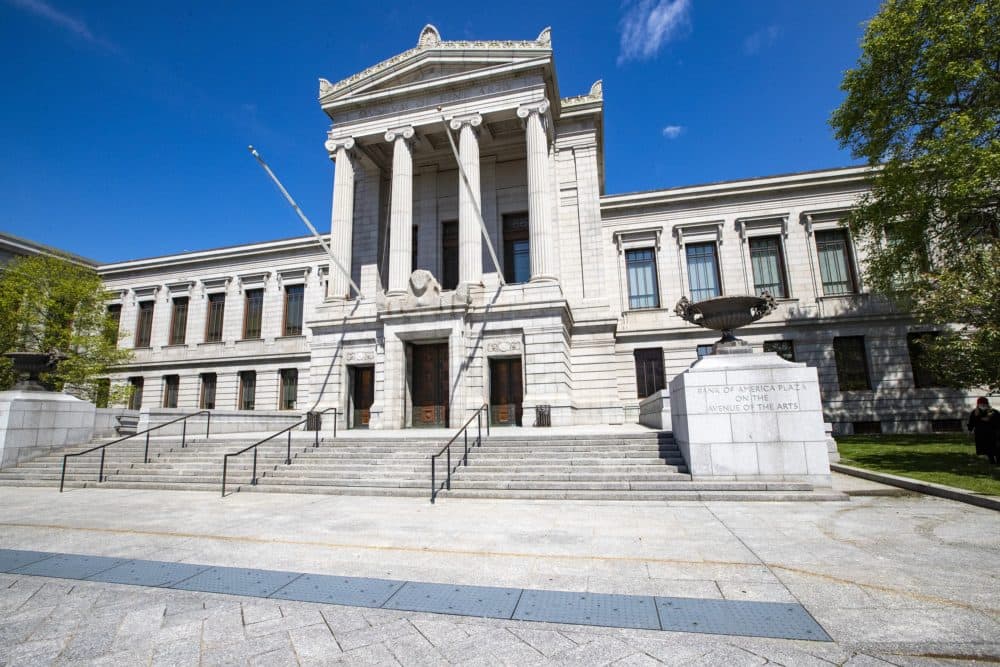Advertisement
MFA Employees Say Unionization Was A Long Time Coming

When Jon Feng joined the staff of the Museum of Fine Arts in Boston two years ago, he was realizing a dream. The museum was one of his favorite places; he visited it practically every other week. Feng never finished college, and he remembers that a bachelor’s degree was preferred on the application to become a representative in the member and visitor services department — essentially, a customer support role. Somehow, though, he got hired. “I really never expected to be able to work there at all,” he says.
Feng, who previously worked in food service, was impressed with his MFA colleagues’ willingness to advocate for themselves. But when the pandemic hit, his department was furloughed, and ultimately about half were laid off, he says. When an ongoing unionizing effort picked up steam in the summer, Feng decided to get more involved. “It felt empowering,” he says.
Last week, Feng and his colleagues voted overwhelmingly to unionize, 133 to 14. MFA employees will join the local arm of the United Auto Workers, which represents workers across a range of industrial, university and non-profit sectors. Museum leadership challenged the eligibility of 41 employees, including curators and conservators, whose ballots were not tallied in the count.
“We support our employees’ right to make this decision and we want to ensure all voices are heard,” MFA director Matthew Teitelbaum said in a statement. “We are pleased that the election played out smoothly and fairly, and we are committed to working with the union moving forward.”
The MFA joins a slew of museums to unionize in recent years, including the New Museum and the Guggenheim in New York and the Museum of Contemporary Art in Los Angeles. The pandemic seems only to have accelerated the wave, with the Philadelphia Museum of Art voting to unionize in August and the Milwaukee Museum of Art, the Carnegie Museums of Pittsburgh and Maine’s Portland Museum of Art launching their own organizing efforts.
“The pandemic, I think, really demonstrated the need for a union even more because it was so clear that people's employment at the museum was really more precarious [than ever],” says Maida Rosenstein, president of United Auto Workers Local 2110, the UAW chapter MFA employees voted to join.
MFA employees launched their union effort a year and a half ago, long before the pandemic was on the horizon. Pay inequity was a top concern, in keeping with an industry-wide reckoning around museum salaries. The results of a compensation study undertaken by the MFA in 2019 were never shared with staff, according to Eve Mayberger, an assistant objects conservator, who was involved in the organizing effort. Frustrated, employees began building support for a union.
“There's been an ongoing conversation about how much below average the museum pays, relative to even the local area,” Mayberger says. On top of that, “the museum really relies on a lot of term positions and contract positions,” she adds. “There are people in my department that have been on, quote unquote, ‘term’ positions, for decades.”
Advertisement
Low wages and a reliance on contingent labor is an industry-wide problem, Rosenstein says, and likely one of the reasons so many museums have voted to unionize in recent years. “Most of these big museums have very corporate boards and top leadership often earns tremendous amounts of money,” she says. “And yet people who do the essential work of the museum are paid pretty low salaries, particularly in light of the level of education and skill that most of these jobs require.”
In fact, many museum employees are overqualified for the work they perform. According to Feng, most of his member services colleagues have B.A.s and many also hold master's degrees. They are paid in the range of $14 to $15 per hour, and turnover is high, he says. “The museum attracts a lot of just really passionate, thoughtful people,” Feng says, many of whom hope to move up the museum’s ranks. “But it's just a bummer because they have to leave because they can't afford working at the museum.”
In August, after months of closure, the MFA laid off 57 employees, while 56 took early retirement. Workers involved in the organizing effort hoped the union would put them in a stronger position in the event of further layoffs. Mayberger points to the Museum of Modern Art in New York, which did not lay off or furlough any of its employees who are part of the museum’s 49-year-old union. “That being said, MoMA did lay off all their part-time educators, but they weren't part of the union,” she says, adding that MFA organizers intended to negotiate as many returning part-time workers into the union as possible.
Organizers also expressed a desire to improve the museum’s practices around diversity, equity and inclusion, in both its hiring policies and interactions with the public. Still looming is a widely-publicized incident in which students from Dorchester's Helen Y. Davis Leadership Academy were racially profiled and harassed on a trip to the museum last year.
“When I tell my friends or people I meet that I work [at the MFA], they have a very respectable view of the museum, like they see it as this very woke, progressive place. And I think the museum does a good job of projecting that and certainly benefits from it,” Feng says. “But there's definitely a lot of contradictions within its structures.”
